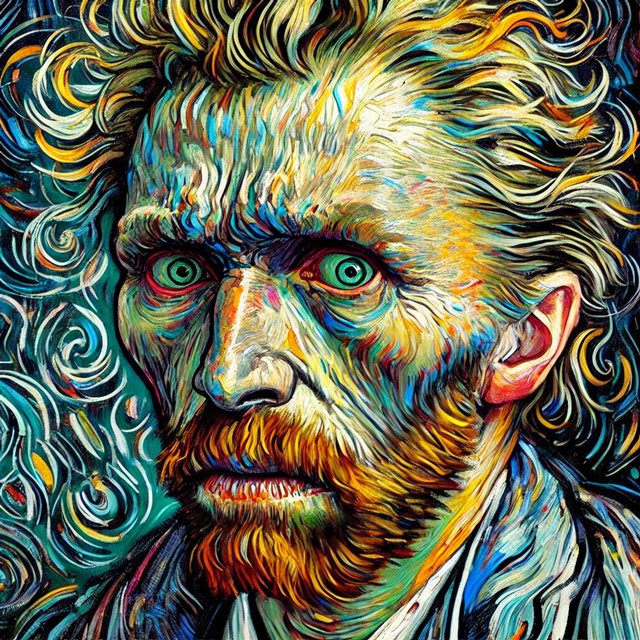
Vincent van Gogh is one of the most famous artists in history. His vibrant, swirling paintings and tragic life have become legendary. People often call him a “tortured genius,” believing his incredible talent was the result of a brilliant but troubled mind. But was Van Gogh really a genius, or was his artistic success more about his madness? The truth is, Van Gogh’s story is more complicated than the myth of a creative genius suffering for his art. In fact, much of what made him famous may have come from his mental instability rather than any extraordinary artistic gift.
The Romanticized Narrative: How History Built Van Gogh’s ‘Genius’
Let’s face it, history loves a good story. Van Gogh’s life, filled with struggle, mental breakdowns, and an untimely death, is perfect for the “tortured genius” narrative. However, this view of Van Gogh as a genius wasn’t always popular. During his lifetime, Van Gogh’s work went mostly unappreciated. He sold only a handful of paintings, and the art world saw him as something of an oddball.
But after his death, a different story began to take shape. Van Gogh’s brother, Theo, played a major role in this transformation. Theo worked in the art business and had connections with key players in the field. After Vincent’s death, Theo promoted his brother’s work tirelessly, painting Vincent as a misunderstood genius whose suffering gave birth to extraordinary art.
Early biographers, particularly those close to Theo, helped cement this narrative. In their eyes, Van Gogh wasn’t just a man suffering from mental illness—he was a visionary, someone whose pain opened the door to revolutionary art. This romanticized view caught on, and Van Gogh became the symbol of the tortured artist, someone who created because they couldn’t escape the madness within.
This narrative, while touching, doesn’t tell the whole story. It leaves out important details about Van Gogh’s struggles with mental illness and how they may have influenced his art in ways we don’t fully understand.
The Proof of His Insanity: Van Gogh’s Mental Health
Van Gogh’s mental health was a constant struggle throughout his life. He battled severe depression, psychosis, and possibly epilepsy. Historians have also speculated that he may have suffered from bipolar disorder or borderline personality disorder. These diagnoses help explain many of Van Gogh’s erratic behaviors.
In his letters to his brother Theo, Van Gogh often wrote about his mental state. He described feeling overwhelmed by emotions and thoughts he couldn’t control. His moods swung wildly from manic episodes, where he worked obsessively, to deep depressions, where he couldn’t even pick up a brush. One of the most famous examples of Van Gogh’s instability is the incident where he cut off part of his ear after an argument with fellow artist Paul Gauguin. This act shocked those around him, but it wasn’t the first sign of his deteriorating mental health.
In 1889, Van Gogh admitted himself to an asylum in Saint-Rémy-de-Provence, hoping to find some peace from his tortured mind. While there, he continued to paint, producing works that are now considered masterpieces. However, these paintings were created during intense periods of psychological breakdowns. Van Gogh’s doctors at the time believed he suffered from acute psychosis, which caused hallucinations, paranoia, and severe anxiety.
If these aren’t the symptoms of a man driven by insanity, what are they? Van Gogh’s art can’t be separated from his mental state, and his mental state was far from genius—it was unstable, unhealthy, and, frankly, terrifying at times.
His Art: Insane Scribblings or Revolutionary Vision?
When people look at Van Gogh’s paintings, they often see a brilliant use of color and movement. Works like The Starry Night and Sunflowers are vibrant and filled with energy. But was this technique the result of creative genius, or was it a symptom of Van Gogh’s mental instability?
Van Gogh’s use of color is one of the things that sets his work apart from other artists of his time. He used bold, almost unnatural colors to express emotion. Many believe this was his way of interpreting the world around him in a unique way. But, according to some experts, this style might not have been as calculated as it seems. During his manic episodes, Van Gogh’s perception of reality could have been altered. The intense colors and chaotic brushstrokes we admire might have been less about creative choice and more about his inability to control his emotions and actions.
Take The Starry Night, for example. This painting is often described as a masterpiece, a vision of the night sky filled with swirling patterns and bright stars. But Van Gogh painted this while he was in the asylum, experiencing severe mental distress. The swirling patterns in the painting might reflect his hallucinations or his inability to focus on reality. Could this really be the mark of genius, or is it the mark of someone who was deeply unwell?
The same argument can be made for his famous Sunflowers series. While these bright, cheerful flowers are celebrated today, Van Gogh painted them during a period of intense depression. The flowers, with their wilting stems and drooping petals, could symbolize Van Gogh’s own sense of hopelessness. Again, is this artistic brilliance, or is it the work of a man in the throes of a mental breakdown?
The Role of Theo Van Gogh: Enabler or Support System?
Van Gogh’s relationship with his brother Theo played a crucial role in his career. Theo was not only Vincent’s confidant, but also his financial supporter and art dealer. Without Theo’s constant encouragement and financial backing, it’s possible that Van Gogh would have given up painting altogether.
But was Theo more than just a supportive brother? Some might argue that Theo enabled Vincent’s madness. Theo encouraged Vincent to continue painting, even when it was clear that his mental health was deteriorating. He praised Vincent’s work and pushed him to keep going, which may have fueled Vincent’s manic episodes. Was Theo helping his brother realize his artistic potential, or was he feeding into Vincent’s illness?
On the other hand, Theo’s role in promoting Van Gogh’s work after his death cannot be overlooked. Theo worked tirelessly to ensure that Vincent’s paintings were exhibited and appreciated by the art world. He helped shape the narrative of Van Gogh as a misunderstood genius. Without Theo, it’s unlikely that Van Gogh would have achieved the posthumous fame he enjoys today.
Theo’s actions raise an interesting question: Did Van Gogh’s art gain recognition because of its merit, or because of Theo’s efforts to create a myth around his brother’s life and work? The answer may lie somewhere in between.
Critics and Contemporaries: Did Anyone Actually Think He Was a Genius?
During Van Gogh’s lifetime, few people saw him as a genius. In fact, many of his contemporaries dismissed him as eccentric or outright insane. Paul Gauguin, who briefly lived with Van Gogh in Arles, was one of the few artists who spent time with him. Gauguin described Van Gogh as difficult and unpredictable, particularly during his manic episodes. Their friendship ended after the infamous ear-cutting incident, and Gauguin distanced himself from Van Gogh.
Other artists of the time, such as Claude Monet and Pierre-Auguste Renoir, had little to say about Van Gogh. He wasn’t part of the major artistic movements of the time, and his work didn’t gain much attention. Critics, too, were largely unimpressed by his early exhibitions. Van Gogh’s thick, expressive brushstrokes and vibrant colors were seen as overly emotional and chaotic—far from the controlled, harmonious art that was popular at the time.
Even after his death, it took years for Van Gogh’s work to gain the recognition it has today. His first major exhibition, held in Paris in 1901, more than a decade after his death, was the turning point. Critics began to reassess his work, and the idea of Van Gogh as a visionary, rather than a madman, started to take hold. But during his life, Van Gogh was seen as more insane than genius.
Could Insanity Be Van Gogh’s True Legacy?
Van Gogh’s life was dominated by his mental illness, and it’s impossible to separate his art from his mind. For some, this raises the question: Should we celebrate Van Gogh’s work as genius, or should we see it as a reflection of his madness? Perhaps it’s both.
Mental illness can shape creativity in unexpected ways. Some argue that Van Gogh’s mental instability allowed him to see the world differently, and that this unique perspective is what makes his art so special. Others believe that his illness hindered his ability to fully control his work, resulting in paintings that are more chaotic than intentional.
Modern audiences often romanticize the idea of the “tortured artist.” Van Gogh fits neatly into this trope, and his mental illness adds to the intrigue surrounding his work. But is this romanticization fair to Van Gogh, or to other artists who struggle with mental health issues? We may never know how much of Van Gogh’s art was driven by genius and how much was driven by madness.
What we do know is that Van Gogh’s legacy is tied to his mental state. Whether we view him as a genius or as a tragic figure, his art continues to captivate us, and his life story keeps us fascinated.
The Cult of the Tortured Genius: Why We Love the Van Gogh Story
There’s a reason we love the idea of the “tortured genius.” It gives us a way to explain the unexplainable. Van Gogh’s art is difficult to categorize; it doesn’t fit neatly into any one style or movement. Calling him a genius who was driven by madness makes his work easier to understand. It lets us believe that his pain somehow gave him a special insight into the world.
The myth of the tortured genius is appealing because it reinforces the idea that great art comes from great suffering. This idea is deeply embedded in our culture, and Van Gogh’s story fits perfectly into it. Movies, books, and documentaries about his life often focus on his struggles with mental illness, painting him as a tragic hero who sacrificed his sanity for his art.
But this narrative might do more harm than good. It reinforces the idea that mental illness is somehow necessary for creativity, which isn’t true. Many artists create incredible work without experiencing mental health issues, and those who do struggle often face difficulties that hinder their ability to create. The romanticization of Van Gogh’s illness overlooks the pain he endured and the very real impact it had on his life.
Final Verdict: Genius, Insane, or Something In Between?
So, was Van Gogh a genius or simply insane? The answer is probably a mix of both. His mental illness clearly influenced his work, but that doesn’t mean his art lacked intention or skill. Van Gogh had a unique way of seeing the world, and his paintings reflect that. Whether his vision came from genius or madness—or a bit of both—his work continues to resonate with people today.
Ultimately, we can appreciate Van Gogh’s art without needing to label him as a tortured genius or a tragic madman. His life was complicated, and so was his mind. We may never fully understand what drove him to create such extraordinary works, but we can still admire them for what they are: beautiful, moving, and unforgettable.
As artist Edvard Munch once said, “Without anxiety and illness, I would have been like a ship without a rudder.” Perhaps Van Gogh felt the same way.




